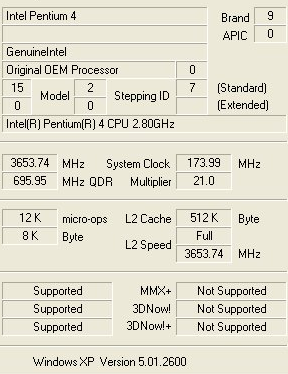System setup, notes, results
System Setup and Benchmarking- Intel Pentium 4 2800MHz S478 Northwood CPU (21x133FSB)
- Asus P4B-533E i845E motherboard run with synchronous memory speeds
- 256MB Corsair XMS3200 C2 RAM
- VapoChill Premium Edition refrigerant-based cooling system
Other hardware components
- Leadtek GeForce4 Ti 4600 128MB at stock speeds (300/648)
- 120GB Western Digital 120JB 7200rpm hard drive with 8MB cache.
- 21" Sony G500 FD monitor
Software
- Windows XP Professional Build 2600.xpclient.010817-1148
- Intel Application Accelerator drivers
- Detonator XP 40.41 drivers
- Sisoft Sandra 2002 Professional Service Pack 1
- Pifast v41
- Lame v3.91 MP3 encoding with Razor-Lame 1.15 front-end
- PCMark 2002
- 3DMark 2001SE
- Comanche 4 benchmark
- Serious Sam 2 Valley of the Jaguar Timedemo
- Quake 3 v1.30
Noise
Extensive air cooling usually involves a great deal of noise. We often have to sacrifice quietness for performance. On that note, the VapoChill Premium edition impressed me with its quietness of operation. Whilst not ultra-quiet, the gentle hum of the compressor is a relatively easy noise to live with. It's far more palatable that, say, a Delta 80mm at 12v.
Overclocking
I've mentioned that air or standard watercooling can take us only so far in terms of processor overclocking. I've also stated that cooling your processor further should allow you to run your system at a higher speed. Now is the time to prove it. I replaced the supplied 2.53GHz processor with our 2.8GHz Northwood, and also replaced the supplied Samsung PC2700 with some proven Corsair XMS3200 C2. I wanted to ensure that we had the best possible hardware to test with. This particular CPU is stable at around 3350MHz / 1.65v load voltage once cooled with an Alpha 8942T and Delta at 7v; that's about as loud as I'm willing to go on a day-to-day basis. Temperatures hover at around the 55c mark.
Feeling a little apprehensive I switched the VapoChill on and waited for it to boot. Once the evaporator had reached -5c, we were up and running. I decided to apply 1.8v to the processor in the knowledge that it would undervolt to around 1.73 - 1.75v, the maximum that I would give a P4 0.13u CPU, irrespective of cooling. Managing to boot into Windows at 3.2GHz, 3.3GHz, and 3.4GHz gave me confidence. After some extended testing (and BIOS resetting) I managed to gain some sort of stability at the following lofty figure.

Whilst not being terribly stable on a long-term basis, it did allow me to conduct my series of benchmarks without issue. 3.65GHz at 1.75v load voltage was something that, frankly, surprised me. Running at 3.5GHz on a day-to-day basis would be simple affair with this P4 2.8 and VapoChill. I'm a novice R134a-based user and I'm sure that some fine-tuning could have given us a higher result. As it stands, 3.65GHz is the highest clock speed I've been privy too. What's more, it was done with an off-the-shelf VapoChill unit, and not with some ad-hoc, one-run peltier cooling.
Running the 2.8GHz Pentium 4 at 3.6Ghz+ with 1.75v of load voltage resulted in a Windows load temperature of around 16 -18c. Whilst this may sound high, try to think of just how much heat is being generated by the said processor at that speed and voltage. The fact that we can keep it under ambient temperatures is impressive.
I'll be including benchmarks from P4 2.8GHz running at its default speeds and it at 3.65GHz to show you just how far you can currently go. It's up to you to decide whether it is worth it or not.
I'll be running the 2.8GHz stock CPU with memory at 133MHz (strict timings) and the 3.65GHz CPU with memory at 174MHz.
On a separate note I'd like to mention just how well written the main Vapochill manual is. It's obvious that Asetek have given it a lot of care and attention. If you read it carefully, you'll feel at ease with phase change cooling.









